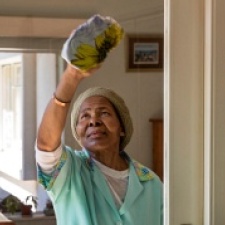Advanced Search
Search Results
170 results found
There are over 1.5 million home-based workers in Nepal who represent 22 per cent of total employment. About 1.01 million of these workers are non-agricultural. This brief presents data from the 2017/18 LFS, including some comparisons with the 2008 LFS.
This document reflects on the work of Asiye eTafuleni, a non-profit organization operating out of inner-city Durban, South Africa. Asiye eTafuleni’s team has worked alongside informal workers for decades, whose award-winning work is founded on the belief that inclusive processes are the best way to...
This brief presents key indicators on home-based workers and their work across the world. Globally, 260 million women and men produce goods or provide services from their homes: 86% are in developing and emerging countries and 57% are women. This WIEGO Statistical Brief offers insight into where and...
In South Africa, informal workers in general, and women informal workers in particular, have been disproportionately hard hit by measures to prevent the spread of COVID-19. This policy brief provides details of the impacts on informal workers' livelihoods of pandemic restriction orders and...
Most domestic workers in Nepal are employed in live-out arrangements with multiple employers while others, many of them adolescent girls, live in the home of a single employer. Among recommendations made in this policy brief are that domestic workers are registered with local authorities, which will...
Delhi, India’s capital and a bustling metropolis, is home to many migrant workers from across the country. For most women migrants, domestic work is a viable option owing to ease of entry, low skill requirements and flexibility. However, these workers face high levels of risk, precarious working...
Domestic workers in Bangladesh carry the heavy cost of inadequate investment in the provision of social protection and services and survey findings show that the majority of domestic workers earn a wage that is insufficient to cover their basic needs. This policy brief makes recommendations for...
Domestic workers in Bangladesh carry the heavy cost of inadequate investment in the provision of social protection and services and survey findings show that the majority of domestic workers earn a wage that is insufficient to cover their basic needs. This policy brief makes recommendations for...
In recent years, home-based work has grown in Pakistan. This growth is due to an increase in the number of women doing home-based work, while the number of men in home-based work has declined. From 2013/14 to 2017/18, the number of home-based workers increased from approximately 3.59 to 4.37 million...
In Bangladesh, there were about 3.2 million non-agricultural and 7.4 million agricultural home-based workers, according to the 2016/17 Labour Force Survey. This represents, respectively, about 5.2 and 12.1 per cent of the employed population aged 15 and older. The data presented in this brief are...
Videos / Slideshows / Audio
Millions of women work long hours, in dangerous conditions, for little pay. They are fighting for change, with the help of ILO Convention 189 on Decent Work for Domestic Workers. Watch this video to learn how.
Workers Education/Organizing Materials
This manual helps street vendors learn more about the regulations that govern public space and how to defend the right to work in public space. It describes successful actions taken by street vendor organizations. And it offers information to help you organize and negotiate with local government.
WIEGO Working Papers
Mike Rogan reviews how informal workers are taxed, why there is growing interest in taxing them, and whether they should be included in the tax net.



